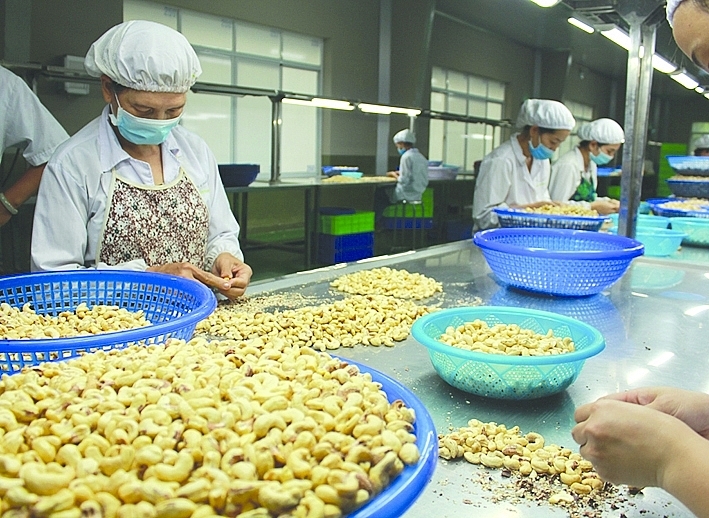 |
| Cashew nuts are one of the typical products that Vietnam increases imports from Cambodia. Photo: Internet |
Imports increased sharply
As a country with strengths in producing and exporting agricultural products, it is expected that Vietnam’s agricultural, forestry and fishery exports will earn an impressive amount of about US$ 55 billion this year. However, every year, Vietnam spends billions of dollars importing agricultural products to serve consumption and processing needs. Vietnam mainly imports agricultural, forestry and fishery products from the US, China, Brazil, and New Zealand. However, it is notable that in the past two years, Cambodian agricultural products have suddenly “landed” in Vietnam. As a result, this country has become the main supplier to the Vietnamese market.
Statistics from the General Department of Customs show that, in 2012, agricultural products imported from Cambodia only reached US$ 214.8 million, with only four items including wood and wood products, corn, aquatic products, and rubber. However, rubber is the import item with the highest value when reaching the USwith $171.2 million. By 2015, Vietnam imported the above four items from Cambodia, but the turnover increased to US$ 537.6 million. In 2020, the number of imports will reach about US$ 756.2 million. Furthermore, in addition to four items: wood products and wood products, corn, aquatic products, and rubber, in 2020, Vietnam started to import vegetables and fruits from Cambodia.
The year 2021 witnessed the rapid “landing” of Cambodian agricultural products into Vietnam when the import turnover increased to US$3.487 billion, an increase of 4.6 times compared to 2020 and 16.2 times in 2012. Vietnam’s main imports from Cambodia include cashew nuts, wood and wood products, corn, soybeans, rubber, rice and vegetables. The import turnover of rubber and cashew nuts surpassed US$1 billion, reaching US$1.54 billion and US$ 1.87 billion, respectively. However, even the massive import of cashews from Cambodia in 2021 shows signs of commercial fraud.
A Cambodian Ministry of Agriculture, Forestry and Fisheries report shows that the country’s agricultural exports in 2021 will reach nearly US$5 billion. Vietnam is the leading country in importing Cambodian agricultural products, with nearly US$3.5 billion. Compared to the same period last year, Cambodia exported 3.5 million tons of rice to Vietnam, up 61%. Other agricultural products also increased by 10-400% in turn. For example, with cashew nuts, in 2021, 99% of Cambodia’s output will be exported to Vietnam, with nearly 1 million tons, up 4.6 times over the same period in 2020.
In the markets that supply agricultural products to Vietnam, Cambodia has gradually occupied the leading position in recent years, especially in 2021. Even in September 2021, this country rose to the top position, 1st place, surpassing both the US and China. Entering the ten months of 2022, Vietnam has spent up to US$ 2.429 billion to import agricultural products from Cambodia. Although the import turnover of many products from Cambodia decreased sharply, it is still one of the main suppliers of agricultural products to Vietnam.
Cambodia becomes a competitor
Assessing Cambodian agricultural products, agricultural expert Vo Tong Xuan analyzed: Cambodian agricultural products have the advantage that when farming uses very few pesticides, good seeds, and fertile soil, agricultural products are not only delicious but also guaranteed quality, favoured by consumers. For example, Cambodian rice is favoured by the Vietnamese market because of its delicious, flexible quality and lower price than similar Vietnamese rice products.
In recent years, Vietnamese people and businesses have tended to go to Cambodia to rent agricultural land to grow potatoes, cassava, sugarcane, and corn or raise cows because the country’s agricultural land fund is very large. The price of agricultural land in Cambodia for rent is low, and the cost of hiring labour is cheaper than in Vietnam. By the time they are harvested, these agricultural products are brought back to Vietnam for consumption, so there is a sudden increase in Cambodian agricultural products exported to our country.
“Frankly, the import to serve the needs of domestic production and consumption is inevitable. However, Vietnamese goods have to compete with Cambodian agricultural products in the “home market”. Especially with the production orientation in favour of high-quality goods, Cambodian agricultural products become a direct competitor to Vietnamese goods in the international market,” said expert Vo Tong Xuan.
He cited rice products, although, after Vietnam, Cambodia quickly became Europe’s fourth largest rice supplier. Last time, Cambodia’s rice exports to China also increased sharply, while Vietnamese exports to this market decreased. Notably, Cambodian fruit products are continuously licensed to export to the Chinese market. Most recently, after mango and banana, Cambodian longan was officially exported to the Chinese market. In addition, Cambodia is completing the final procedures to export the first pangasius to China.
According to the Import-Export Department (Ministry of Industry and Trade), in the coming time, some agricultural products of Vietnam will face stiff competition from similar products of Cambodia and Thailand in the Chinese market.
Some agricultural experts see that the world market is in a changing trend. Consumers not only eat delicious, clean food but also care about products that are good for health and the environment. Even China, a market considered “easy” in the past few years, is no longer “easy”. They began to raise standards and tighten food safety conditions for imported goods. Cambodia is not only going in the right direction but also adapting quickly, so export turnover has grown well. If Vietnam does not change its production thinking and approach to the market, making a brand, the risk of market share in China will sooner or later be taken over by its Cambodian rival.
